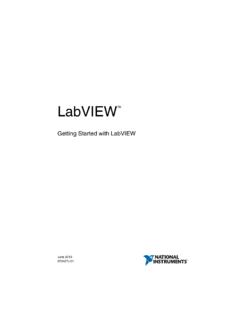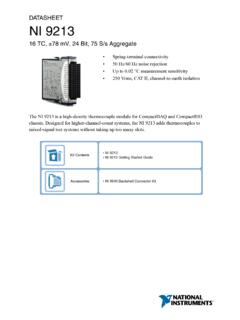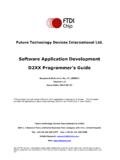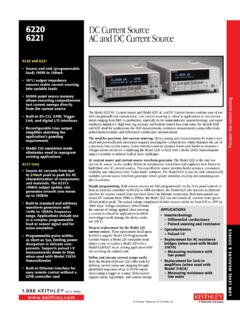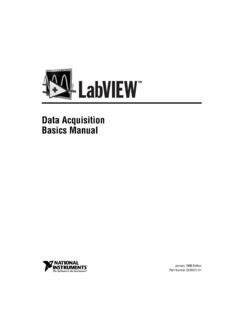Transcription of Certified LabVIEW Developer (CLD) Certification and Exam ...
1 100900A-01 Certified LabVIEW Developer (CLD) Certification and Exam Overview 2012 National Instruments Corp. All rights reserved Page 1 of 13 Certification Overview The National Instruments LabVIEW Certification Program consists of the following three Certification levels: 1. Certified LabVIEW Associate Developer (CLAD) 2. Certified LabVIEW Developer (CLD) 3. Certified LabVIEW Architect (CLA) Each level is a prerequisite for the next level of Certification . The CLAD Certification is a prerequisite to taking the CLD exam. The CLD Certification is a prerequisite to taking the CLA exam.
2 There are no exceptions to the requirements for each exam. A CLAD demonstrates a broad and complete understanding of the core features and functionality available in the LabVIEW Full Development System and possesses the ability to apply that knowledge to develop, debug, and maintain small LabVIEW modules. The typical experience level of a CLAD is approximately 6 to 9 months in the use of the LabVIEW Full Development System. A CLD demonstrates experience in developing, debugging, and deploying and maintaining medium-to-large scale LabVIEW applications. A CLD is a professional with cumulative experience of approximately 12 to 18 months developing medium to large applications in LabVIEW .
3 A CLA demonstrates mastery in architecting LabVIEW applications for a multi- Developer environment. A CLA not only possesses the technical expertise and software development experience to break a project specification into manageable LabVIEW components, but also has the experience to see the project through by effectively utilizing project and configuration management tools. A CLA is a professional with a cumulative experience of approximately 24 months in developing medium to large applications in LabVIEW . 100900A-01 Certified LabVIEW Developer (CLD) Certification and Exam Overview 2012 National Instruments Corp.
4 All rights reserved Page 2 of 13 Exam Overview Your test computer will have the LabVIEW Full Development System version 2011 or later installed for developing your application. After October 1, 2012, LabVIEW 2012 may be installed. Contact your proctor or testing center prior to the exam to get additional details and familiarize yourself with the specific LabVIEW version that will be used to develop your application. You may request the proctor to allow you a few minutes before your exam to customize the LabVIEW environment for your needs or to familiarize yourself with the environment.
5 The proctor will only hand over the exam when you are ready to begin working on the exam. Please note that you will not receive extra time for the exam to compensate for unfamiliarity with the LabVIEW environment. Refer to LabVIEW Development Systems comparison for details about LabVIEW Full Development System features. Exam Duration: 4 hours Style of exam: Practical application development Passing grade: 70% The exam validates problem solving skills, knowledge, and experience in the development of measurement and automation applications using LabVIEW . The exam involves software development only and does not involve any hardware.
6 The use of resources available in LabVIEW , such as the LabVIEW Help, examples, and templates are allowed during the exam. Externally developed VIs or resources are prohibited. The exam packet will include a USB memory stick with a VI and controls in a folder hierarchy that you must use to develop you application. You must not rename the main VI, provided components, or alter the folder hierarchy. All your development VIs and controls must be saved in the provided folder hierarchy. A detailed application specification will be provided. The specifications consist of general and technical requirements for the application.
7 You must not detach the binding staple, copy, or reproduce any section of the exam document. Failure to comply will result in failure. After you have completed your exam, you must transfer the solution to the provided USB memory stick. Please validate the copied solution on the USB stick before returning it to your proctor. You must not detach the binding staple, copy, or reproduce any section or solution of the exam. Failure to comply will result in failure. 100900A-01 Certified LabVIEW Developer (CLD) Certification and Exam Overview 2012 National Instruments Corp.
8 All rights reserved Page 3 of 13 Exam Topics 1. Design Concepts 2. User Interface Design 3. Block Diagram Layout and Style 4. Programming Practices 5. SubVI Design Practices 6. Architecture Selection 7. Timing 8. Error Handling 9. Documentation 10. Testing 100900A-01 Certified LabVIEW Developer (CLD) Certification and Exam Overview 2012 National Instruments Corp. All rights reserved Page 4 of 13 Exam Topics (Overview) Topic Subtopic 1. Design Concepts a. Modularity, scalability, readability, and maintainability b. Cohesion and coupling c.
9 Hierarchical design d. File structure 2. User Interface (front panel window) Design Practices a. Coloring scheme b. Grouping and aligning objects c. Setting properties d. Customizing objects e. State management i. Static or dynamic ii. At initialization and application stop f. Icon design 3. Block Diagram Design Practices a. Data flow b. Enhancing readability 4. Programming Practices a. Data elements b. Functions and subVIs c. Programming structures d. Data structures e. References, Property Nodes 5. SubVI Design Practices a. Modularity and cohesion b. Front panel layout c.
10 Connector pane and icon 6. Design Pattern Selection a. Scalability and maintainability b. Responsive and non-blocking c. Design patterns: i. Simple state machine ii. User interface event handler iii. Queued message handler iv. Producer/consumer (data) v. Producer/consumer (events) vi. Functional global variable 7. Timing a. Timing functions b. Timing mechanisms i. Event structure timeout ii. Synchronization function timeout iii. Timed structures c. Timing Express VIs and functional global variables 8. Errors a. Error handling b. Error reporting 9. Documentation a.

